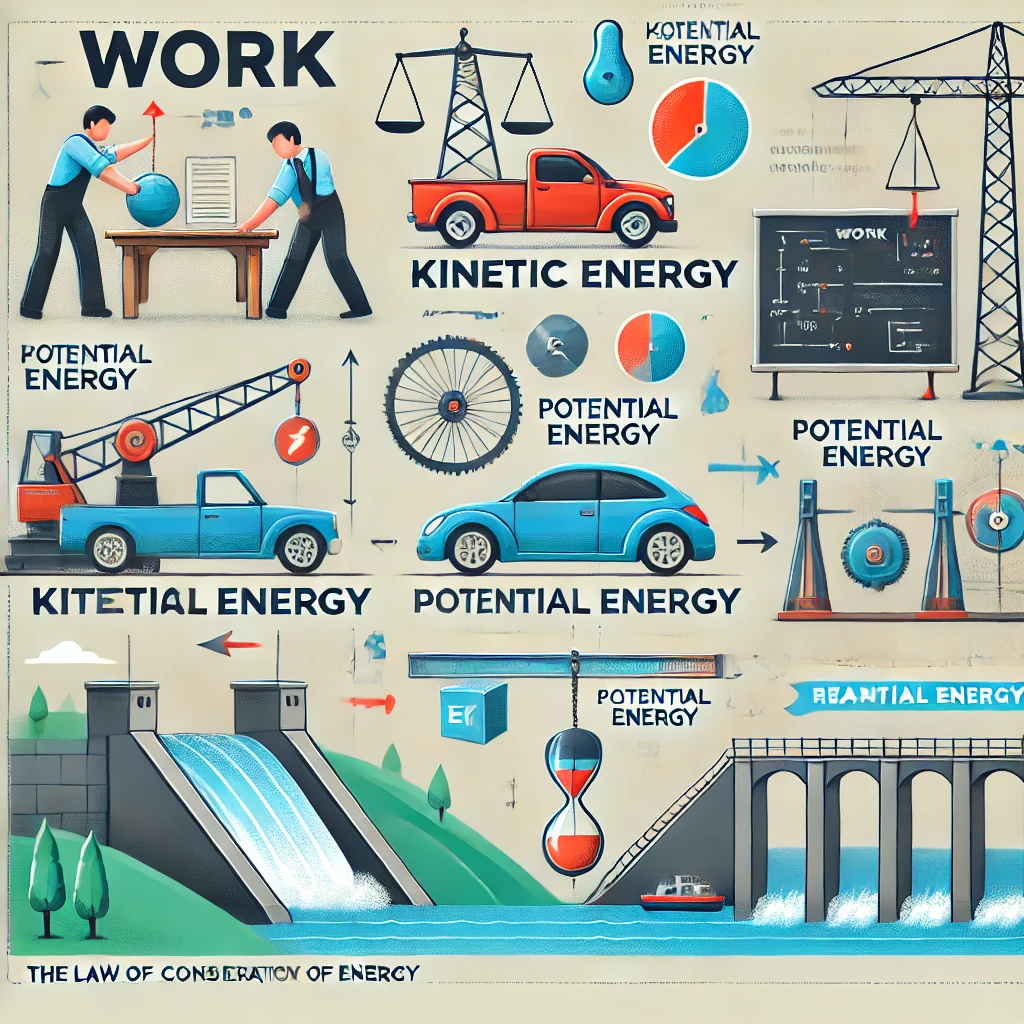Introduction
Work and energy are fundamental concepts in physics that play a crucial role in our daily lives. From lifting an object to driving a car, these principles are constantly at play. Understanding work and energy not only helps in grasping basic physics but also lays the foundation for more advanced scientific studies. In this article, we will explore the definitions, types, formulas, and real-world applications of work and energy.
What is Work?
In physics, work is defined as the transfer of energy when a force is applied to an object, causing it to move in the direction of the force. Mathematically, work is given by:
Where:
- W = Work done (Joules, J)
- F = Force applied (Newtons, N)
- d = Displacement of the object (meters, m)
- θ = Angle between force and displacement
Conditions for Work to be Done
For work to be considered as being done, two essential conditions must be met:
- A force must be applied to an object.
- The object must move in the direction of the applied force.
If either of these conditions is not met, no work is done. For instance, if you push a wall with all your strength but the wall does not move, no work is done in terms of physics.
Types of Work
Work can be categorized into three main types based on the direction of force and displacement:
- Positive Work: When the force applied and displacement are in the same direction, work is said to be positive. Example: A person pushing a moving trolley.
- Negative Work: When the force applied is opposite to the direction of displacement, work is considered negative. Example: Friction acting against a moving object.
- Zero Work: If there is no displacement, or the force is perpendicular to the displacement, no work is done. Example: Carrying a bag while walking on a horizontal road.
What is Energy?
Energy is the capacity to do work. It exists in various forms and is measured in Joules (J). Without energy, work cannot be performed, making it an essential concept in physics and everyday life.
Types of Energy
Energy can be classified into several types, each with its unique characteristics:
1. Kinetic Energy
Kinetic energy is the energy possessed by a moving object. It is given by the formula:
- KE = Kinetic Energy (Joules, J)
- m = Mass of the object (kg)
- v = Velocity of the object (m/s)
Examples:
- A moving car
- A rolling ball
- A flying airplane
2. Potential Energy
Potential energy is the stored energy an object possesses due to its position or configuration. The most common form is gravitational potential energy, calculated as:
- PE = Potential Energy (Joules, J)
- m = Mass of the object (kg)
- g = Acceleration due to gravity (9.8 m/s²)
- h = Height above the ground (m)
Examples:
- Water stored in a dam
- A stretched rubber band
- A raised hammer
3. Mechanical Energy
Mechanical energy is the sum of kinetic and potential energy in a system.
This type of energy is commonly observed in simple machines and moving objects.
4. Thermal Energy
Thermal energy is the energy possessed by an object due to the motion of its particles. It is responsible for heat transfer.
Examples:
- Boiling water
- Heat from the sun
- Fire producing warmth
5. Chemical Energy
Chemical energy is stored in substances and released during chemical reactions.
Examples:
- Food digestion
- Burning fuel
- Explosions
6. Electrical Energy
Electrical energy results from the movement of electrons through a conductor.
Examples:
- Lightning
- Powering household appliances
- Electric circuits
The Law of Conservation of Energy
The Law of Conservation of Energy states that energy cannot be created or destroyed; it can only be transformed from one form to another. The total energy in a closed system remains constant.
Example:
- A falling object converts potential energy into kinetic energy until it hits the ground, where some energy is converted into sound and heat energy.
Real-World Applications of Work and Energy
Work and energy principles have countless applications in daily life and various industries:
- Transportation: Vehicles use fuel to convert chemical energy into kinetic energy for movement.
- Electricity Generation: Power plants convert mechanical energy into electrical energy.
- Sports: Athletes use muscular energy to perform work, like running, jumping, or lifting weights.
- Construction: Cranes and machines use mechanical energy to lift heavy loads.
- Household Appliances: Electrical energy is converted into heat energy in devices like ovens and heaters.
- Hydropower Plants: Water stored in dams has potential energy, which is converted into mechanical and electrical energy.
